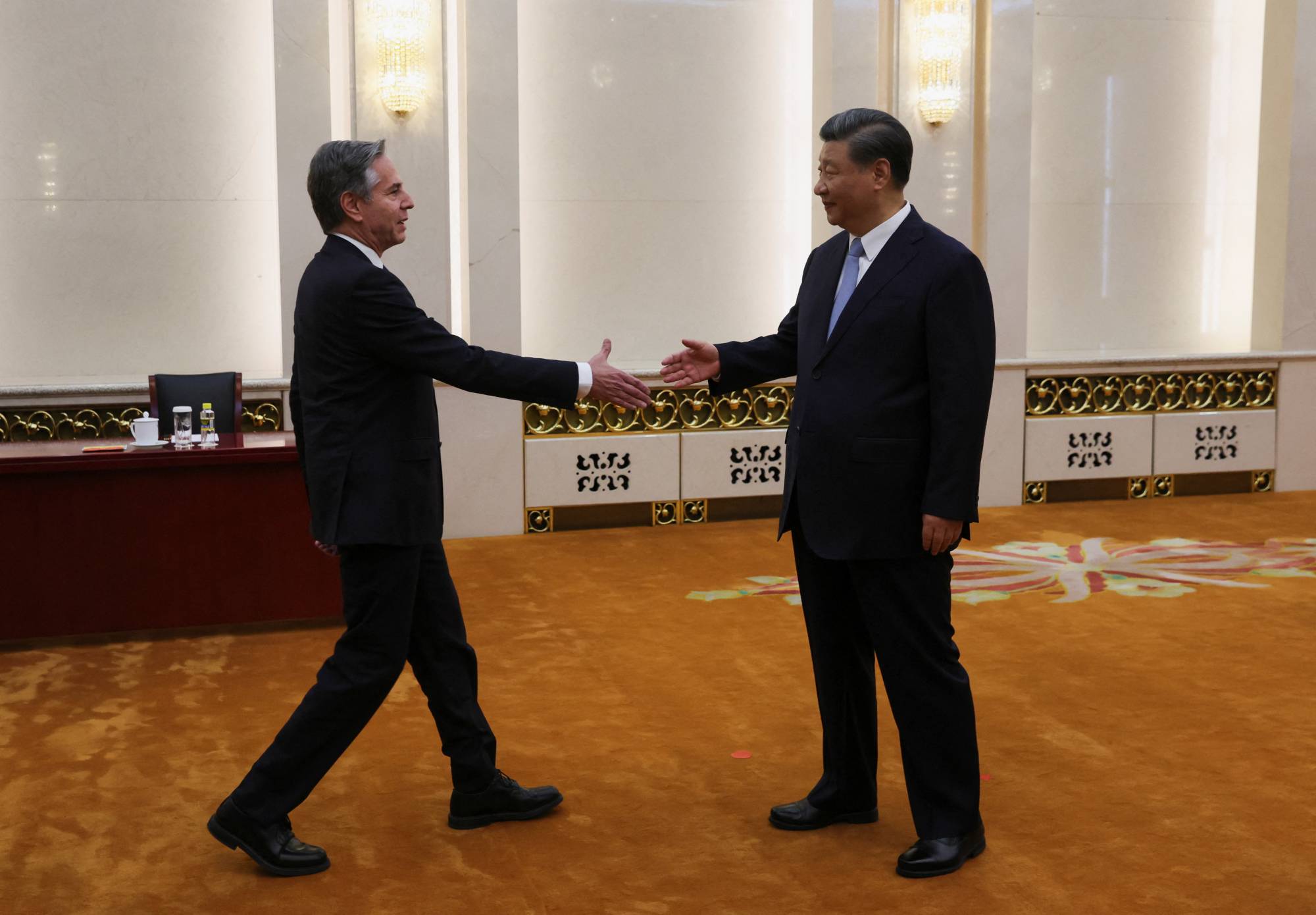The direct meeting with China’s leader is a sign of continued effort to ease tensions, but officials expect little progress on core issues like Taiwan, trade and Chinese support of Russia.

Secretary of State Antony J. Blinken met with China’s leader, Xi Jinping, in Beijing on Friday, as the two countries worked to hold together a fractious relationship despite disputes over the economy, national security and geopolitical frictions in East Asia, the Middle East and Ukraine.
Both China and the United States have said they were hoping for progress on a few smaller, pragmatic fronts, including improving communications between their militaries and easing travel between the countries. But they remain at a standstill on fundamental strategic issues, including trade policies and territorial conflicts in the South China Sea and over Taiwan.
And with other disputes looming, both sides acknowledged the danger of the relationship sliding into further conflict.
The Biden administration is deeply concerned that cheap Chinese exports are threatening U.S. jobs, and is worried about China’s support of Russia in the Ukrainian war. And China has accused the United States of working to encircle Chinese interests in the Pacific.
Still, in his opening remarks to Mr. Blinken, Mr. Xi struck a conciliatory note.
“China is happy to see a confident, open, prosperous and thriving United States. We hope the U.S. can also look at China’s development in a positive light,” Mr. Xi said, according to Chinese state media.
Earlier in the day, Mr. Blinken spent more than five hours with China’s foreign minister, Wang Yi, in meetings and at a working lunch at the Diaoyutai State Guesthouse in Beijing.
Mr. Wang, too, adopted a somewhat less confrontational tone than in the past, telling Mr. Blinken that “the China-U.S. relationship is beginning to stabilize,” and that its future would rely on the decisions of both countries. During Mr. Blinken’s visit last year, Mr. Wang had laid blame for the deterioration of ties squarely with the United States, which he said needed to “reflect upon itself.”
Relations Between China and the U.S.
- Trouble on Horizon: Secretary of State Antony Blinken arrived in China to try to preserve the recent stabilization of ties between the United States and China, as tensions over trade, territorial disputes and national security threaten to derail relations again.
- America’s Favorite Drone Maker: U.S. authorities consider the Chinese company DJI a security threat. Congress is weighing legislation to ban it, prompting a lobbying campaign from the company, which dominates the commercial and consumer drone markets.
- Chinese Export Surge: The decision by a Massachusetts solar company to abandon plans to build a $1.4 billion U.S. factory highlights the risks amid a flood of Chinese clean energy exports.
- Biden’s Industrial Agenda: President Biden’s trillion-dollar effort to invigorate American manufacturing and speed a transition to cleaner energy sources is colliding with a surge of cheap exports from China, threatening to wipe out the investment and jobs central to his economic agenda.
But Mr. Wang also warned on Friday that the negative factors in the relationship were “increasing and building.”
“The United States has adopted an endless stream of measures to suppress China’s economy, trade, science and technology,” Mr. Wang said, according to a readout from the Chinese foreign ministry. “This is not fair competition, but containment, and is not removing risks, but creating risks.”
Mr. Blinken said that he hoped to move forward on agreements on topics including counternarcotics and safety issues regarding artificial intelligence.
“I hope that we can make some progress on the issues that our presidents agreed we should cooperate on, but also clarify our differences, our intent, and make very clear to each other where we stand,” Mr. Blinken said.

U.S. officials want China to make progress on stemming the flow to the United States of chemicals used to make fentanyl, and to strengthen communication between their militaries, among other goals. Chinese officials said they wanted to promote more cultural exchanges between the countries, and press the United States to end interrogations of Chinese students at the border.
Despite the effort being put in by both sides to improve relations, more factors appear to be driving the two countries apart than keeping them together. Geopolitical disputes over Ukraine and the Middle East have presented new challenges. And with an election approaching in the United States, the Biden administration is under pressure to offer more protections for American factories against Chinese imports.
In recent weeks, U.S. officials have begun more urgently raising concerns about China’s economic assistance to Russia, saying they view that support as a pivotal factor in the course of the war. They have held out the possibility of further sanctions, including on Chinese banks.
In a briefing with reporters in mid-April, a senior Biden administration official said that China had provided Russia with significant quantities of semiconductors, drones, machine tools and a combustible material called nitrocellulose. Those products are helping to fill critical gaps in Russian supply chains that might otherwise cripple their war effort, causing the Russian defense sector to expand more quickly than American officials had believed possible, the official said.
And in a government-sponsored export control conference held in Washington at the end of March, officials with the Office of the Director of National Intelligence told executives of American tech companies that China had recently taken the lead in the countries’ long-running defense industry research collaborations, which in past decades had been led by Russia.
China has denied providing weapons for Russia’s war effort, which Washington has said would be a red line. Otherwise, Chinese officials have shown little inclination to scale back their ties with Russia. On Thursday, soon after Mr. Blinken arrived in Beijing from Shanghai, President Vladimir V. Putin of Russia announced that he would visit China in May, in likely his first overseas trip since securing re-election last month.
Asked about Mr. Putin’s announcement at a routine news briefing on Friday, a spokesman for the Chinese foreign ministry said he had no information to provide at the moment. But when Mr. Xi met with Russia’s foreign minister in Beijing earlier this month, Mr. Xi said that he and Mr. Putin had agreed to “maintain close contact to ensure the smooth and stable development of China-Russia relations.”

American officials have said they are coordinating with Europe to pressure China on Russia, but the Chinese government is taking its own steps to shore up its ties in Europe. Mr. Xi earlier this month hosted Germany’s chancellor, Olaf Scholz, who highlighted Germany’s commitment to doing business with China.
Trade frictions are another issue between the United States and China, as American officials weigh adding new tariffs on Chinese imports and restricting more exports of U.S. technology to China out of national security concerns.
Economic ties between the countries have long provided a source of strength for the relationship, a point Mr. Blinken reiterated while meeting with business executives in Shanghai on Thursday.
But with an election looming in the United States, and the potential prospect of a return of Donald J. Trump to the presidency, economic issues could turn more explosive.
To try to jump-start the economy, Mr. Xi and other Chinese leaders are stoking factory production and exports. American leaders believe those exports could undercut U.S. manufacturing, particularly the new factories making semiconductors, solar panels and car batteries that the Biden administration is investing tens of billions of dollars in this year.
China knows that it likely has little room to sway the United States on trade, given the American domestic political situation, said Xie Tao, the dean of the School of International Relations and Diplomacy at Beijing Foreign Studies University. Instead, the Chinese government seems to be putting its focus on people-to-people exchanges, Professor Xie said. Chinese media has frequently raised Mr. Xi’s goal, announced after the summit near San Francisco last year, of inviting 50,000 young Americans to visit China.
“The Chinese government is really investing a lot of energy in shaping the future generation of Americans’ view of China,” he said.
Excerpts: New York Times




COMMENTS